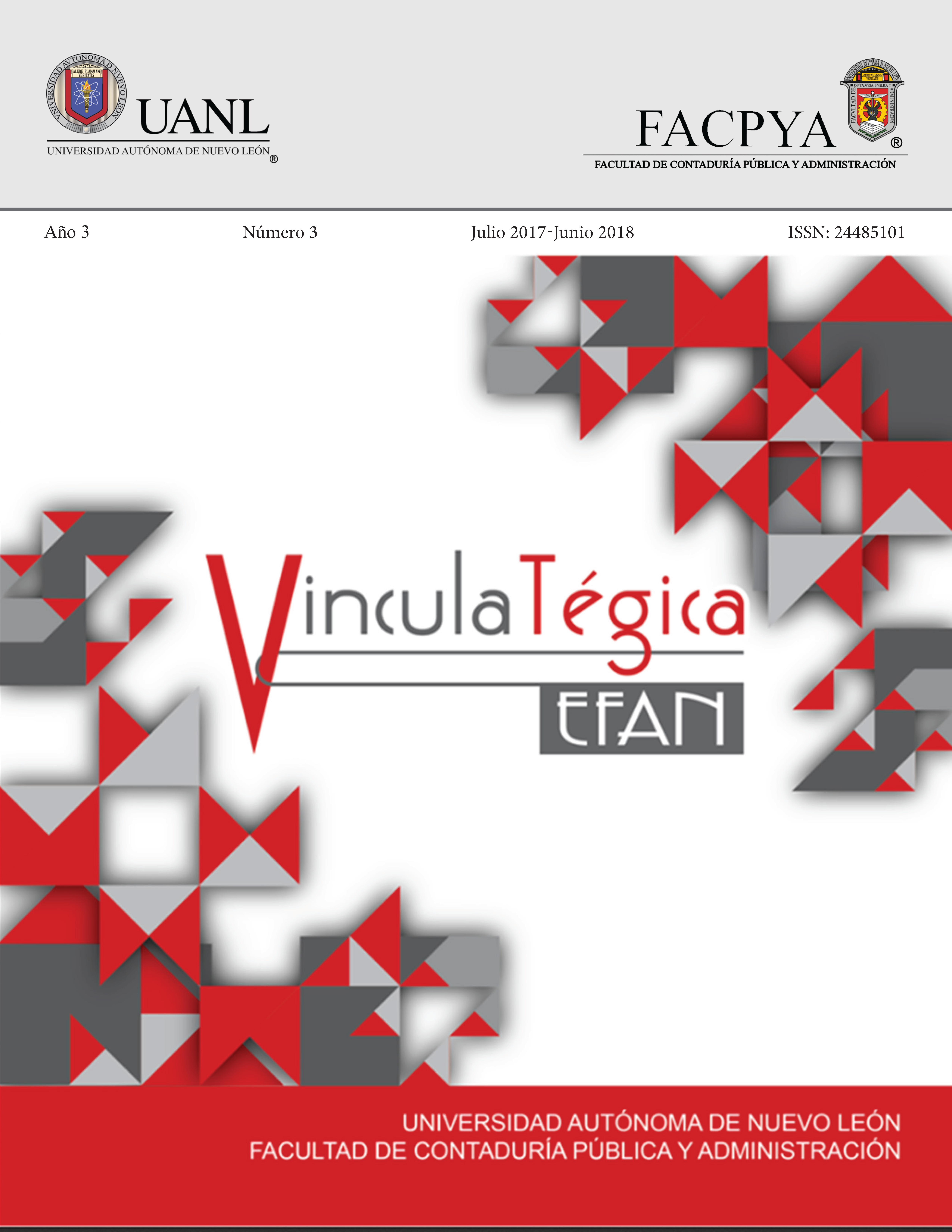Gestión de la Cadena de Sumistro en Empresa de Manufactura Avanzada
DOI:
https://doi.org/10.29105/vtga3.3-937Keywords:
empuje-tirón, comercio exterior, incidentes, logísticaAbstract
In the decade of the 70s, the union of the management with the manufacture originated the concept of management of the production or the manufacture and in the decade of the '80 the term of Management of Supply Chain began to be used, as a sequence of processes that are connected through product flows, information and funds along the stages in which are involved suppliers, manufacturers, distributors and retailers to provide the customer the product that needs. The objective of this case study was to show the results of the diagnostic of the incidents that occur in the supply chain of an exporter company that changes from production processes known as push, which begin and take place in anticipation of customer orders, to other forms of processes identified as pull that begin with the customer's order. For methodology it was used the Kendall (W) coefficient of concordance, taking in consideration the opinion of ten technical specialists of this company, which allowed to order the impact of these incidents and then verify them using the reliability interval 42 with Z = 1.96 . In the job predominates an approach to logistics as the physical flow of goods coming in and going out as well as the services that link together the company to the exterior world. The results served as information to rank critical incidents and have scientific basis to determine, later, the causes that generate them and the ways to counter them.
Downloads
References
Anaya, J.J.& Polanco, S., (2007) Innovación y mejora de procesos logísticos: Análisis, diagnóstico e implementación de sistemas logísticos, (2da. ed.), Madrid
Ardila, W., Romero, D., & Gonzalez, F. (2014) Estrategias para la Gestión de Riesgos en la Cadena de Suministros. ” Excellence in Engineering To Enhance a Country’s Productivity” Guayaquil, Ecuador.
Ballesteros, D. P.; Ballesteros, P. P., «La logística Competitiva y la Administración de la Cadena de Suministro» Scientia et Technica, 2004, vol. 10, no. 24, ISSN 0122-1701.
Ballou, R. H., (2004). | Logística de Administración de la Cadena de Suministro, México: Pearson Educación.
Bancomext. Empresas que apoyamos. Exportadores, 2016. México. Recuperado de http://www.bancomext.com/empresas-queapoyamos/exportadores.
Cannella, S., Ciancimino, E., Framinan, J.& Disney, S. (2010). Los cuatro arquetipos de cadenas de suministro. Universia Business Review. Recuperado de: https://ubr.universia.net/article/viewFile/742/868.
Chopra, S. & Meindl, P. (2008). Administración Cadena de Suministro. México: PEARSON Educación.
Cortés-Reyes, E. (2010). Métodos estadísticos de evaluación de la concordancia y la reproducibilidad de pruebas diagnósticas. Revista Colombiana de Obstetricia y Ginecología, Vol. (61), 247-255. Recuperado de: http://www.scielo.unal.edu.co/scielo.php?script=sci_abstract&pid=S0034-74342010000300009&lng=es&nrm= DOI: https://doi.org/10.18597/rcog.271
Flynn, B.B., Huo, B. & Zhao, X. (2010) The impact of supply chain integration on performance: A contingency and configuration approach. Journal of Operation Managements, vol. (28), 58-71. Recuperado de http://www.sciencedirect.com/science/article/pii/S0272696309000412 DOI: https://doi.org/10.1016/j.jom.2009.06.001
Gideon, L. (2012). Handbook of Survey Methodology for the Social Sciences. Springer Science & Business Media, New York. DOI: https://doi.org/10.1007/978-1-4614-3876-2
Giusti, F. (2017). 3 pasos para evitar fallas en la cadena de suministro. Recuperado de: https://www.beetrack.com/es/blog/comoevitar-fallas-en-la-cadena-de-suministro-en-3-pasos
Handfield, R & Nichols, E. (2009) Introduction to Supply Chain Management (1a ed.). USA: Pearson
Hayes, B. (1999). Measuring costumer satisfaction. ASQC. Quality Press. Wisconsin-USA
Harrington, L. (2016). White paper de DHL. Recuperado de: https://www.bvdinfo.com/en-uss/blog/gestion-de-la-cadena-desuministros-y-riesgo-de-cr/fallas-en-la-cadena-de-suministro-causan-ineficie
Instituto Nacional de Administración Pública y SAT. Control de la operación aduanera. 2012. México. Recuperado de http://www.sat.gob.mx/fichas_tematicas/Documents/Control_operacion_aduanera2012.pdf.
Israel, G., D. (1992). Determining Sample Size. Recuperado de https://a7852d97-a-62cb3a1assites.googlegroups.com/site/estadisticayunpocomas/tamañomuestra.pdf?attachauth
Justribo, D. (2014). Factores que revolucionan la cadena de suministro en Latinoamérica. Recuperado de: http://www.cioal.com/2014/09/10/revolucionando-la-cadena-de-suministro/.
Lozada Zambrano, R. G. (2009) Diseño y propuesta de la cadena de abastecimiento, mediante la gestión por procesos de la empresa Logistichdine SA. (Tesis de Licenciatura, Escuela Politécnica Nacional,Quito Ecuador). Recuperado de: http://bibdigital.epn.edu.ec/handle/15000/1259
Mangan, J.; Lalwani, C.& Butcher, T. (2008), Global Logistics and Supply Chain Management. United Kingdom: John Wiley and Sons
Martha, J., Subbakrishna, S. (2002). Targeting a Just-in-Case Supply Chain for the Inevitable Next Disaster. Supply Chain Management Review. Recuperado de: https://www.highbeam.com/doc/1G1-91562584.html
Mendoza, A., Fontalvo, T. & Visbal, D. (2014). Optimización Multiobjetivo en una Cadena de Suministro. Revista Ciencias Estratégicas. Vol. (22). Recuperado de. http://www.redalyc.org/articulo.oa?id=151339264008.
Mora García, L. (2010). Gestión Logística Integral. Bogotá: ECOE Ediciones.
Moral, I. (2013). Medidas de asociación.Revista Oficial de la Sociedad Española de Enfermería Nefrológica. Recuperado de: http://www.revistaseden.org/files/13-cap%2013.pdf
Nickl, M. (2005). La evolución del concepto "logística" al de "cadena de suministros" y más allá. Compras y Existencias. Vol(140). Recuperado de: https://www.revistavirtualpro.com/print/logistica/9
Pardillo Baez, Y., & Gómez Acosta, M. I.. (2013). Modelo de diseño de nodos de integración en las cadenas de suministro. Ingeniería Industrial, vol,(34), 96-107. Recuperado de http://scielo.sld.cu/scielo.php?script=sci_arttext&pid=S181559362013000100010&lng=es&tlng=es.
Pilot. (2016). Competitividad 4.0 Las Nuevas Tecnologias Al Servicio De La Cadena De Suministros. 2016, Sitio Web: Http://Www.Aragonempresa.Com/Paginas/Congresos-Foro-Pilot.
PROMÉXICO. Contratos internacionales. 2015. México. http://www.promexico.gob.mx/documentos/pdf/ContratosDeCompraventaInternacional.pdf.
PROMÉXICO. Decídete a exportar. Guía Básica. 2015. http://www.promexico.mx/documentos/pdf/guia-basica-del-exportador-promexico.pdf. México. Recuperado Recuperado de: de:
PROMÉXICO. Pasos para exportar. 2015. México. Recuperado de: http://www.promexico.gob.mx/es/mx/pasos-exportar.
Hernadez Samperi, R., Fernandez Collado, C., & Baptista Lucio, P. (2010 ). Metodología de la Investigación. Mexico: 5a edicion Mc Graw.
Simchi-Levi, D.; Kamimsky, P. & Simchi-Levi, E. (2008), Designig and Managing the Supply Chain:Concepts, Strategies and Case Studies, (3rd ed.). New York: McGraw-Hill
Schein, E. (1988). Consultoría de procesos, su papel en el desarrollo organizacional. México: Addison-Wesley.
Downloads
Published
How to Cite
Issue
Section
License

This work is licensed under a Creative Commons Attribution 4.0 International License.
a). Authors keep copyright and give the journal the right of the first publication of the work under a Creative Commons attribution license. This license allows others to share the work as long as original authorship and initial publication in this journal is acknowledged.
b). Authors may make other independent and additional contractual agreements for the non-exclusive distribution of the version of the article published in this journal (e.g., include it in an institutional repository or publish it in a book) as long as they clearly indicate that the work was published for the first time in this journal.







